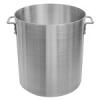This may help explain the logic
Serving Size
Some products have a RACC of 30 grams, which needs to be converted to a household measure for the serving size. A RACC of 30 grams is approximately equal to a household measure of 1 ounce, but 1 ounce technically weighs 28.35 grams. If the household serving size is 1 ounce, should the gram weight equivalent of the label serving size be 30 grams or rounded to 28 grams?
For nutrition labeling purposes, if the household serving size is 1 ounce, manufacturers should use 28 grams as the rounded metric weight equivalent, as explained in 21 CFR 101.9(b)(5)(viii).
(5) For labeling purposes, the term common household measure or common household unit means cup, tablespoon, teaspoon, piece, slice, fraction (e.g., 1⁄4 pizza), ounce (oz), fluid ounce (fl oz), or other common household equipment used to package food products (e.g., jar, tray). In expressing serving size in household measures, except as specified in paragraphs (b)(5)(iv), (b)(5)(v), (b)(5)(vi), and (b)(5)(vii) of this section, the following rules shall be used:
(i) Cups, tablespoons, or teaspoons shall be used wherever possible and appropriate except for beverages. For beverages, a manufacturer may use fluid ounces. Cups shall be expressed in 1/4- or 1/3-cup increments. Tablespoons shall be expressed as 1, 1 1/3, 1 1/2, 1 2/3, 2, or 3 tablespoons. Teaspoons shall be expressed as 1/8, 1/4, 1/2, 3/4, 1, or 2 teaspoons.
(ii) If cups, tablespoons or teaspoons are not applicable, units such as piece, slice, tray, jar, and fraction shall be used.
(iii) If paragraphs (b)(5)(i) and (b)(5)(ii) of this section are not applicable, ounces may be used with an appropriate visual unit of measure such as a dimension of a piece, e.g., 1 oz (28 g/about 1⁄2 pickle). Ounce measurements shall be expressed in 0.5 oz increments most closely approximating the reference amount.
(iv) A description of the individual container or package shall be used for single serving containers and for individually packaged products within multiserving containers (e.g., can, box, package). A description of the individual unit shall be used for other products in discrete units (e.g., piece, slice, cracker, bar).
(v) For unprepared products where the entire contents of the package is used to prepare large discrete units that are usually divided for consumption (e.g., cake mix, pizza kit), the fraction or portion of the package may be used.
(vi) Ounces with an appropriate visual unit of measure, as described in paragraph (b)(5)(iii) of this section, may be used for products that naturally vary in size as provided for in paragraph (b)(2)(i)(F) of this section.
(vii) As provided for in § 101.9(h)(1), for products that consist of two or more distinct ingredients or components packaged and presented to be consumed together (e.g. dry macaroni and cheese mix, cake and muffin mixes with separate ingredient packages, pancakes and syrup), nutrition information may be declared for each component or as a composite. The serving size may be provided in accordance with the provisions of paragraphs (b)(2)(i), (b)(2)(ii), and (b)(2)(iii) of this section, or alternatively in ounces with an appropriate visual unit of measure, as described in paragraph (b)(5)(iii) of this section (e.g., declared as separate components: “3 oz dry macaroni (84 g/about 2⁄3 cup)” and “1 oz dry cheese mix (28 g/about 2 tbsp);” declared as a composite value: “4 oz (112 g/about 2⁄3 cup macaroni and 2 tbsp dry cheese mix)”).
(viii) For nutrition labeling purposes, a teaspoon means 5 milliliters (mL), a tablespoon means 15 mL, a cup means 240 mL, 1 fl oz means 30 mL, and 1 oz in weight means 28 g.
(ix) When a serving size, determined from the reference amount in § 101.12(b) and the procedures described in this section, falls exactly half way between two serving sizes, e.g., 2.5 tbsp, manufacturers shall round the serving size up to the next incremental size.
https://www.fda.gov/...bel#ServingSize














